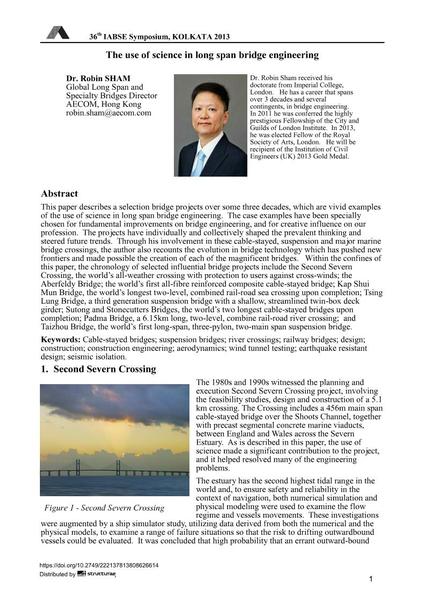The use of science in long span bridge engineering

|
|
|||||||||||
Bibliographic Details
| Author(s): |
Robin Sham
|
||||
|---|---|---|---|---|---|
| Medium: | conference paper | ||||
| Language(s): | English | ||||
| Conference: | IABSE Symposium: Long Span Bridges and Roofs - Development, Design and Implementation, Kolkata, India, 24-27 September 2013 | ||||
| Published in: | IABSE Symposium Kolkata 2013 | ||||
|
|||||
| Page(s): | 1-11 | ||||
| Total no. of pages: | 11 | ||||
| Year: | 2013 | ||||
| DOI: | 10.2749/222137813808626614 | ||||
| Abstract: |
This paper describes a selection bridge projects over some three decades, which are vivid examples of the use of science in long span bridge engineering. The case examples have been specially chosen for fundamental improvements on bridge engineering, and for creative influence on our profession. The projects have individually and collectively shaped the prevalent thinking and steered future trends. Through his involvement in these cable-stayed, suspension and major marine bridge crossings, the author also recounts the evolution in bridge technology which has pushed new frontiers and made possible the creation of each of the magnificent bridges. Within the confines of this paper, the chronology of selected influential bridge projects include the Second Severn Crossing, the world’s all-weather crossing with protection to users against cross-winds; the Aberfeldy Bridge; the world’s first all-fibre reinforced composite cable-stayed bridge; Kap Shui Mun Bridge, the world’s longest two-level, combined rail-road sea crossing upon completion; Tsing Lung Bridge, a third generation suspension bridge with a shallow, streamlined twin-box deck girder; Sutong and Stonecutters Bridges, the world’s two longest cable-stayed bridges upon completion; Padma Bridge, a 6.15km long, two-level, combine rail-road river crossing; and Taizhou Bridge, the world’s first long-span, three-pylon, two-main span suspension bridge. |
||||
| Keywords: |
design cable-stayed bridges seismic isolation railroad bridges rail bridges construction aerodynamics wind tunnel testing suspension bridges construction engineering river crossings earthquake resistant design
|
||||
